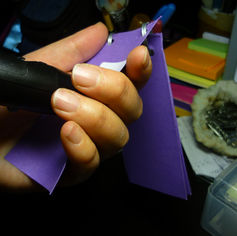Usability Tool: Creating A Low Fidelity Prototype for Visually Impaired Users
Design Problem: Partnered with Rachel Magario, a blind Interaction Designer, to build a low fidelity prototyping tool focused on: aiding visually impaired students as they navigate an academic building on campus.
My Role: UX Visual Collaborator and Testing Analyst
Observe – Evaluate: Using Walkthrough Analysis and Think Aloud Protocol, Rachel was able to test visually impaired students finding a room on campus. I then analyzed recorded footage for gestures, unspoken motions, directions, and graphics.
Discoveries: Visually impaired students used a wide range of different strategies for navigating physical spaces. Strategies included following braille, asking for directions, touching room signs to find the room number, following walls with hands to find openings and assess the surroundings, assistance of a cane or service animal, etc.




Make – Iterate: The concept for a low fidelity prototyping tool came to Rachel one day when she was using a technology called Pen Friend to label groceries. The Pen Friend used RIFD stickers as voice activated labels that could be read by a hand held device. Rachel thought by using existing technology, and stripping out the costly software programming costs, this solution could be leveraged as a way to low fidelity prototype for the visually impaired.
Prototype Modeling Included:
Design 1: Paper prototype held together by staples.
Cons: Paper crumpled under the pressure of the Pen Friend.
Design 2: Foam backed paper prototype.
Cons: Bulky and difficult to hold, and folded too easily causing user error in navigation.
Design 3: Card stock only prototype held with rings.
Cons: Unable to tell where the prototype started and finished.
Design 4: Transparency paper, foam board prototype held with rings.
Winner: Final design used transparency sheets to increase durability, and re-use of RFID stickers. A thin piece of foam board was added to mark when volunteers had reached their desired location.




Reflect – Brainstorm | Test: Once the prototype was finalized visually impaired students were asked to navigate the building again. Overall users were able to navigate to their desired location without any problems and enjoyed being included in the design process early on.
Additional Discoveries: RFID stickers were changed to Velcro backed adhesive method to increase ability to reuse and move in real time.
Deliverable: Pen Friend Paper Prototype Tool.
